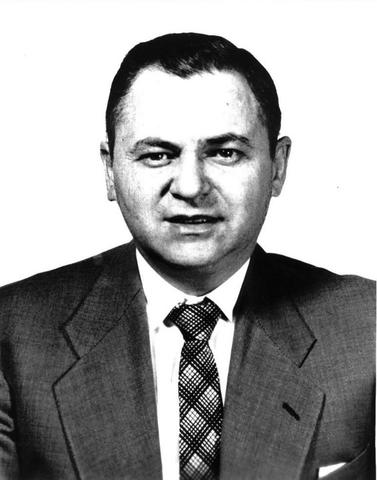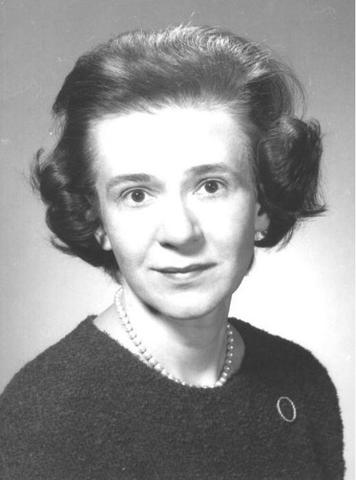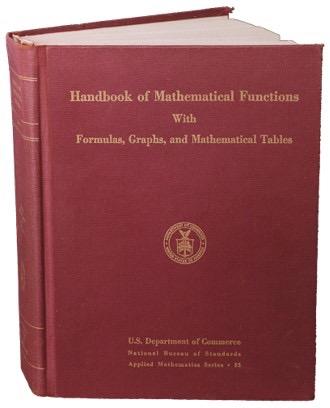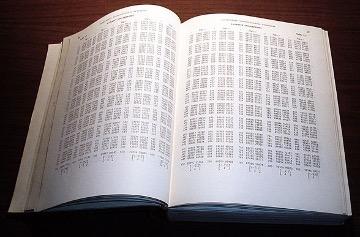Handbook of Mathematical Functions: Abramowitz and Stegun
Date: 1964
Originally conceived as a compendium of mathematical tables for hand computation, the Handbook of Mathematical Functions with Formulas, Graphs, and Mathematical Tables became the most widely distributed and most highly cited NIST publication of all time.
The Handbook of Mathematical Functions with Formulas, Graphs, and Mathematical Tables [1] (HMF) was the culmination of a quarter century of NBS work on mathematical functions which began with the Mathematical Tables Project funded by the WPA. Although the HMF was conceived as a compendium of tables of commonly occurring mathematical functions needed for hand computation, but its impact lasted well into the computer era.
Milton Abramowitz, who was then Chief of the Computation Laboratory of the NBS Applied Mathematics Division, led the project. Abramowitz was born in Brooklyn, NY, in 1915. He received a B. A. from Brooklyn College in 1937 and an M. A. in 1940. He joined the NBS Math Tables Project in 1938 and in 1948 received a Ph.D. in Mathematics from New York University. Abramowitz’ dedication, enthusiasm, and boundless energy led to substantial progress in the project during its first year. The proposed outline for the Handbook called for a series of some 20 chapters, each with a separate author. Authors were drawn from NBS staff and guest researchers, as well as external researchers working under contract. Most chapters would focus on a particular class of functions, providing formulas, graphs, and tables. Listed formulas would include differential equations, definite and indefinite integrals, inequalities, recurrence relations, power series, asymptotic expansions, and polynomial and rational approximations. Material would be carefully selected in order to provide information most important in applications, especially in physics. Consequently, the higher mathematical functions, such as Bessel functions, hypergeometric functions, and elliptic functions, would form the core of the work. Additional chapters would provide background on interpolation in tables and related numerical methods for differentiation and quadrature.


The Handbook project occurred during the period when general-purpose electronic computing machinery was first coming into use in government research laboratories. Nevertheless, most of the tables in the Handbook were generated by hand on desk calculators. However, even at that time it was clear to the developers of the Handbook that the need for tables themselves would eventually be superseded by computer programs which could evaluate functions for specified arguments on demand. By the summer of 1958, substantial work had been completed on the project. Twelve chapters had been completed, and the remaining ones were well underway. The project experienced a shocking setback one weekend in July 1958 when Abramowitz suffered a heart attack and died. Irene Stegun, who was Assistant Chief of the Computation Laboratory, took over management of the project. Stegun, who was born in Yonkers, NY in 1919, had received an M. A. from Columbia University in 1941, and joined NBS in 1943. The exacting work of assembling the many chapters, checking tables and formulas, and preparing the work for printing took much longer than anticipated. Nevertheless, the Handbook of Mathematical Functions, with Formulas, Graphs, and Mathematical Tables was finally issued as Applied Mathematics Series Number 55 in June 1964 [1]. The volume, was originally issued by the U.S. Government Printing Office, and remained in print there until the 1990s, is 1046 pages in length. It remains available as a Dover reprint today. It has also been reprinted (in all or part) by other publishers, such as Moscow Nauka, Verlag Harri Deutsch, and Wiley Interscience.
The Handbook has had enormous impact on science and engineering. Likely the most widely distributed NBS/NIST technical publication of all time. Government sales exceed 150,000 copies, with commercial sales are estimated at three to six times this number. The Handbook’s citation record is also remarkable. More than 23,000 citations were logged by Science Citation Index (SCI) between 1973 and 2001, and citations have remained steady at more than 2,000 per year since then. During the mid-1990s, for example, about once every 1.5 hours of each working day some author, somewhere, made sufficient use of the Handbook to list it as a reference. The success of the Handbook was due to several factors. It collected in one place, and in a well-organized way, the most important information needed to make use of mathematical functions in practical applications. It served to standardize notations and normalizations for the special functions of applied mathematics, thus easing the communication of scientific results.
- Milton Abramowitz and Irene A. Stegun, eds., Handbook of Mathematical Functions With Formulas, Graphs, and Mathematical Tables, NBS Applied Mathematics Series 55, National Bureau of Standards, Washington, DC (1964).
- R. F. Boisvert and D. W. Lozier. Handbook of Mathematical Functions. In A Century of Excellence in Measurements, Standards, and Technology (D. R. Lide, ed.), NIST Special Publication 958, 2001. https://nvlpubs.nist.gov/nistpubs/sp958-lide/135-139.pdf



